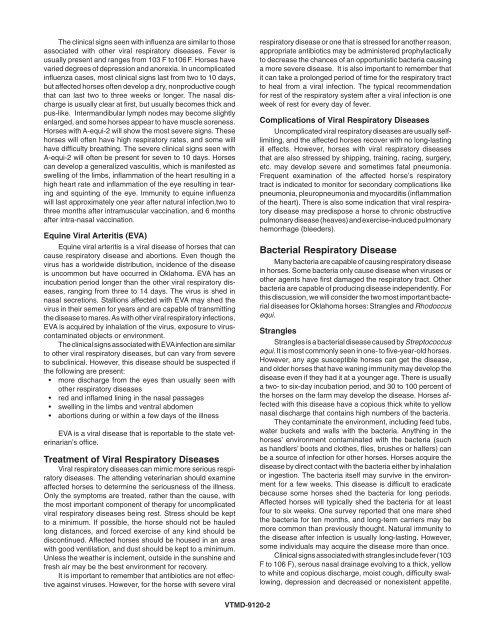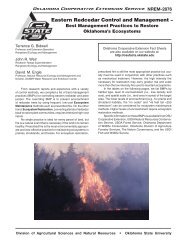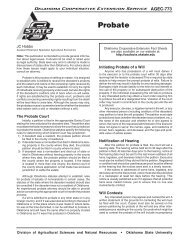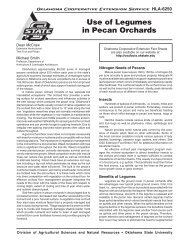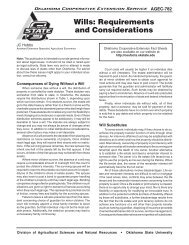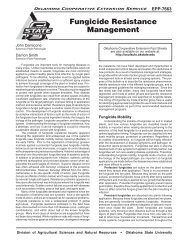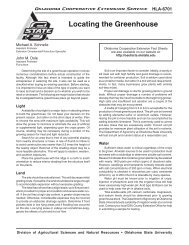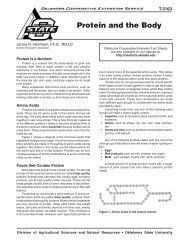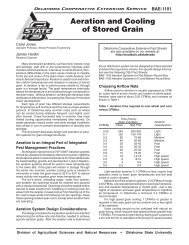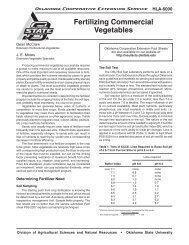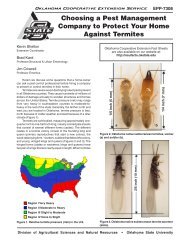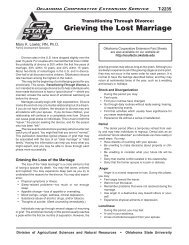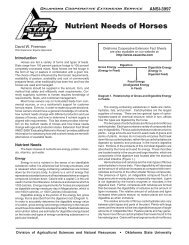Respiratory Diseases in Horses: - OSU Fact Sheets - Oklahoma ...
Respiratory Diseases in Horses: - OSU Fact Sheets - Oklahoma ...
Respiratory Diseases in Horses: - OSU Fact Sheets - Oklahoma ...
Create successful ePaper yourself
Turn your PDF publications into a flip-book with our unique Google optimized e-Paper software.
The cl<strong>in</strong>ical signs seen with <strong>in</strong>fluenza are similar to those<br />
associated with other viral respiratory diseases. Fever is<br />
usually present and ranges from 103 F to106 F. <strong>Horses</strong> have<br />
varied degrees of depression and anorexia. In uncomplicated<br />
<strong>in</strong>fluenza cases, most cl<strong>in</strong>ical signs last from two to 10 days,<br />
but affected horses often develop a dry, nonproductive cough<br />
that can last two to three weeks or longer. The nasal discharge<br />
is usually clear at first, but usually becomes thick and<br />
pus-like. Intermandibular lymph nodes may become slightly<br />
enlarged, and some horses appear to have muscle soreness.<br />
<strong>Horses</strong> with A-equi-2 will show the most severe signs. These<br />
horses will often have high respiratory rates, and some will<br />
have difficulty breath<strong>in</strong>g. The severe cl<strong>in</strong>ical signs seen with<br />
A-equi-2 will often be present for seven to 10 days. <strong>Horses</strong><br />
can develop a generalized vasculitis, which is manifested as<br />
swell<strong>in</strong>g of the limbs, <strong>in</strong>flammation of the heart result<strong>in</strong>g <strong>in</strong> a<br />
high heart rate and <strong>in</strong>flammation of the eye result<strong>in</strong>g <strong>in</strong> tear<strong>in</strong>g<br />
and squ<strong>in</strong>t<strong>in</strong>g of the eye. Immunity to equ<strong>in</strong>e <strong>in</strong>fluenza<br />
will last approximately one year after natural <strong>in</strong>fection,two to<br />
three months after <strong>in</strong>tramuscular vacc<strong>in</strong>ation, and 6 months<br />
after <strong>in</strong>tra-nasal vacc<strong>in</strong>ation.<br />
Equ<strong>in</strong>e Viral Arteritis (EVA)<br />
Equ<strong>in</strong>e viral arteritis is a viral disease of horses that can<br />
cause respiratory disease and abortions. Even though the<br />
virus has a worldwide distribution, <strong>in</strong>cidence of the disease<br />
is uncommon but have occurred <strong>in</strong> <strong>Oklahoma</strong>. EVA has an<br />
<strong>in</strong>cubation period longer than the other viral respiratory diseases,<br />
rang<strong>in</strong>g from three to 14 days. The virus is shed <strong>in</strong><br />
nasal secretions. Stallions affected with EVA may shed the<br />
virus <strong>in</strong> their semen for years and are capable of transmitt<strong>in</strong>g<br />
the disease to mares. As with other viral respiratory <strong>in</strong>fections,<br />
EVA is acquired by <strong>in</strong>halation of the virus, exposure to viruscontam<strong>in</strong>ated<br />
objects or environment.<br />
The cl<strong>in</strong>ical signs associated with EVA <strong>in</strong>fection are similar<br />
to other viral respiratory diseases, but can vary from severe<br />
to subcl<strong>in</strong>ical. However, this disease should be suspected if<br />
the follow<strong>in</strong>g are present:<br />
• more discharge from the eyes than usually seen with<br />
other respiratory diseases<br />
• red and <strong>in</strong>flamed l<strong>in</strong><strong>in</strong>g <strong>in</strong> the nasal passages<br />
• swell<strong>in</strong>g <strong>in</strong> the limbs and ventral abdomen<br />
• abortions dur<strong>in</strong>g or with<strong>in</strong> a few days of the illness<br />
EVA is a viral disease that is reportable to the state veter<strong>in</strong>arian’s<br />
office.<br />
Treatment of Viral <strong>Respiratory</strong> <strong>Diseases</strong><br />
Viral respiratory diseases can mimic more serious respiratory<br />
diseases. The attend<strong>in</strong>g veter<strong>in</strong>arian should exam<strong>in</strong>e<br />
affected horses to determ<strong>in</strong>e the seriousness of the illness.<br />
Only the symptoms are treated, rather than the cause, with<br />
the most important component of therapy for uncomplicated<br />
viral respiratory diseases be<strong>in</strong>g rest. Stress should be kept<br />
to a m<strong>in</strong>imum. If possible, the horse should not be hauled<br />
long distances, and forced exercise of any k<strong>in</strong>d should be<br />
discont<strong>in</strong>ued. Affected horses should be housed <strong>in</strong> an area<br />
with good ventilation, and dust should be kept to a m<strong>in</strong>imum.<br />
Unless the weather is <strong>in</strong>clement, outside <strong>in</strong> the sunsh<strong>in</strong>e and<br />
fresh air may be the best environment for recovery.<br />
It is important to remember that antibiotics are not effective<br />
aga<strong>in</strong>st viruses. However, for the horse with severe viral<br />
respiratory disease or one that is stressed for another reason,<br />
appropriate antibiotics may be adm<strong>in</strong>istered prophylactically<br />
to decrease the chances of an opportunistic bacteria caus<strong>in</strong>g<br />
a more severe disease. It is also important to remember that<br />
it can take a prolonged period of time for the respiratory tract<br />
to heal from a viral <strong>in</strong>fection. The typical recommendation<br />
for rest of the respiratory system after a viral <strong>in</strong>fection is one<br />
week of rest for every day of fever.<br />
Complications of Viral <strong>Respiratory</strong> <strong>Diseases</strong><br />
Uncomplicated viral respiratory diseases are usually selflimit<strong>in</strong>g,<br />
and the affected horses recover with no long-last<strong>in</strong>g<br />
ill effects. However, horses with viral respiratory diseases<br />
that are also stressed by shipp<strong>in</strong>g, tra<strong>in</strong><strong>in</strong>g, rac<strong>in</strong>g, surgery,<br />
etc. may develop severe and sometimes fatal pneumonia.<br />
Frequent exam<strong>in</strong>ation of the affected horse’s respiratory<br />
tract is <strong>in</strong>dicated to monitor for secondary complications like<br />
pneumonia, pleuropneumonia and myocarditis (<strong>in</strong>flammation<br />
of the heart). There is also some <strong>in</strong>dication that viral respiratory<br />
disease may predispose a horse to chronic obstructive<br />
pulmonary disease (heaves) and exercise-<strong>in</strong>duced pulmonary<br />
hemorrhage (bleeders).<br />
Bacterial <strong>Respiratory</strong> Disease<br />
Many bacteria are capable of caus<strong>in</strong>g respiratory disease<br />
<strong>in</strong> horses. Some bacteria only cause disease when viruses or<br />
other agents have first damaged the respiratory tract. Other<br />
bacteria are capable of produc<strong>in</strong>g disease <strong>in</strong>dependently. For<br />
this discussion, we will consider the two most important bacterial<br />
diseases for <strong>Oklahoma</strong> horses: Strangles and Rhodoccus<br />
equi.<br />
Strangles<br />
Strangles is a bacterial disease caused by Streptococcus<br />
equi. It is most commonly seen <strong>in</strong> one- to five-year-old horses.<br />
However, any age susceptible horses can get the disease,<br />
and older horses that have wan<strong>in</strong>g immunity may develop the<br />
disease even if they had it at a younger age. There is usually<br />
a two- to six-day <strong>in</strong>cubation period, and 30 to 100 percent of<br />
the horses on the farm may develop the disease. <strong>Horses</strong> affected<br />
with this disease have a copious thick white to yellow<br />
nasal discharge that conta<strong>in</strong>s high numbers of the bacteria.<br />
They contam<strong>in</strong>ate the environment, <strong>in</strong>clud<strong>in</strong>g feed tubs,<br />
water buckets and walls with the bacteria. Anyth<strong>in</strong>g <strong>in</strong> the<br />
horses’ environment contam<strong>in</strong>ated with the bacteria (such<br />
as handlers’ boots and clothes, flies, brushes or halters) can<br />
be a source of <strong>in</strong>fection for other horses. <strong>Horses</strong> acquire the<br />
disease by direct contact with the bacteria either by <strong>in</strong>halation<br />
or <strong>in</strong>gestion. The bacteria itself may survive <strong>in</strong> the environment<br />
for a few weeks. This disease is difficult to eradicate<br />
because some horses shed the bacteria for long periods.<br />
Affected horses will typically shed the bacteria for at least<br />
four to six weeks. One survey reported that one mare shed<br />
the bacteria for ten months, and long-term carriers may be<br />
more common than previously thought. Natural immunity to<br />
the disease after <strong>in</strong>fection is usually long-last<strong>in</strong>g. However,<br />
some <strong>in</strong>dividuals may acquire the disease more than once.<br />
Cl<strong>in</strong>ical signs associated with strangles <strong>in</strong>clude fever (103<br />
F to 106 F), serous nasal dra<strong>in</strong>age evolv<strong>in</strong>g to a thick, yellow<br />
to white and copious discharge, moist cough, difficulty swallow<strong>in</strong>g,<br />
depression and decreased or nonexistent appetite.<br />
VTMD-9120-2


